Own Varieties
Seedless varieties
TANGRA – table seedless cultivar
Tangra cultivar was created at the Experimental field of IASS “Obraztsov Chiflik” – Rousse, via inbreeding of hybrid form 3-32 (Bolgar X Alphonse Lavalle) in 1987 by Ivan Todorov.
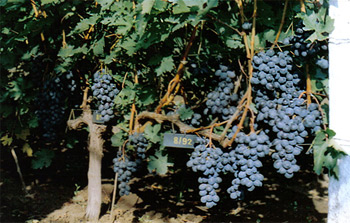
Morphological, agrobiological and technological investigation of the vegetative pedigree of the selected elite seedling 8-92 (3-32 I1) was made together with Galina Dyakova.
Tangra cultivar is late-ripening (it ripens about 5-th October), a typical table seedless variety. The cluster is large, uniform, average weight being about 400 g. The berry is coarse (5.5 g), red-black, with crispy consistence, the taste – neutral harmonious. The seeds are rudiment and they have no unpleasant taste in consumption of grapes. Dry weight of rudiments in 100 berries is 0.30 g.
Yield of grapes per a hectare is about 18 t. Appropriate formations are half-standard Guyot and Lira, and Tendone in warmer regions. Recommended root stocks for the variety are SO4, Chasselas X Berlandieri 41B and Rupestris du Lo. The vines are cold resistant and grapes – with good transportability. The vines have potential ability for higher yield in Lira and Tendone formations, in higher agrotechnical background, including drip irrigation.
In consumptive maturity grapes contain 18% sugars and 4.85 g/l titrum acids. Grapes are not friable and have good transportability.
Tangra cultivar is not susceptible to virgin berries and has higher cold resistance and middle resistance to cryptogamic diseases within Euro-Asian vine. It can be successfully grown in regions, favorable for table grape production, under provision of total temperature sum of the vegetation period more than 3900°C.
Grapes of Tangra cultivar are appropriate for fresh consumption and for production of compotes of high quality. Well kept in refrigerator and can be marketed in the winter.
ZORNITSA – table seedless cultivar
Zornitsa cultivar was created at the Experimental field of IASS “Obraztsov Chiflik” – Rousse, via hybridization of cultivars Rusensko edro and King rubi. The crossing was made in 1986 by Ivan Todorov, and together with Galina Dyakova – the morphological, agrobiological and technological investigations.
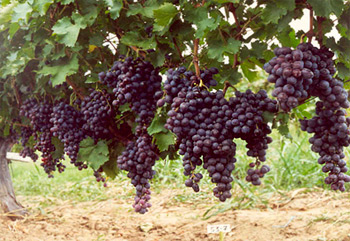
Zornitsa cultivar is a typical table seedless variety, ripening during the second half of September. The cluster is large (400 g), uniform, and the berry is coarse (4.9 g), red-grey colored. The consistence of berry is crispy, and the taste is harmonious with specific delightful fruit nuance. The seeds are rudiment and they have no unpleasant taste in consumption of grapes. Dry weight of rudiments in 100 berries is 0.22 g.
Yield of grapes per a hectare is about 16 t. The vines are cold resistant and grapes – with good transportability. Appropriate root stocks for the variety are SO4, Chasselas X Berlandieri 41B and Rupestris du Lo. Recommended formations are half-standard Guyot and Lira. The vines showed potential ability for higher yielding in Lira formation and in drip irrigation.
In consumptive maturity grapes contain 20% sugars and 5.4 g/l titric acids. During vegetation periods with higher total temperature sums, the sugar content in grapes reaches 22-23 %, which is favorable for production of raisins. Grapes are not friable and have good transportability.
Zornitsa cultivar showed higher winter hardiness and with middle resistance to cryptogamic diseases within the culture vine Vitis vinifera ssp. sativa. In strong damages caused by extreme cold below minus 18-20°C, a very good regenerative ability was expressed.
The cultivar finds good conditions for its growing and fruit-bearing in areas where the total temperature sum for vine vegetation is higher than 3800 – 3900°C.
Grapes of Zornitsa cultivar are appropriate for fresh consumption and for processing into raisins and compotes. Well kept in refrigerator and can be marketed in the winter.
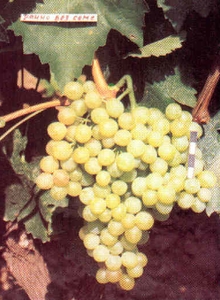
RANNO BEZ SEME
It ripens about 10 of August. The cluster is semi-large, 300 g, semi-compact. The berry is coarse, 2,3 g, ovate, green-yellow. The consistence is crisp, the taste – neutral. The yield of grapes is 1,3 t/da. The grapes contains 20% sugars and 5,0 g/l acids. In over ripening, the sugar content reaches to 24-26%.
The cultivar is appropriate for fresh consummation and for raisins, valuable for the food industry. The cultivar can be cultivated also at foothill places up to 600-700 m above sea.
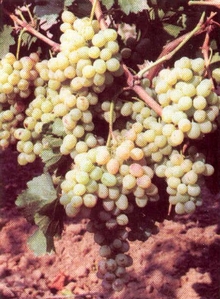
RUSENSKO BEZ SEME
It ripens towards 20 of September. The cluster is semi-large, 300 g, semi-compact. The berry is coarse, 3,5 g, ovate, green-yellow with pink. The consistence is crisp, the taste – neutral. The yield of grapes is 1,4 t/da. The grapes contains 20% sugars and 8,0 g/l acids. In a later vintage, the sugar content increases to 24-26%, this flavors the raisins production. The cultivar is with increased winter resistance and is rot resistant.
It is recommended to be cultivated at the typical for the table grapes production regions.
Seed varieties
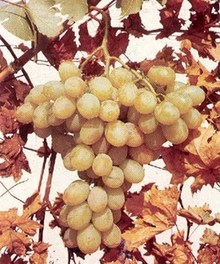
BOLGAR CLONE 14
It ripens at the usual for the cultivar time – from 10 to 15 September. The cluster is very large, 640 g (500 g for the population) loose to semi-compact, uniformed in size and berries coloration. The coefficient of fruit bearing is 0,9, 0,7 being for the population. The clone gives up to 20% higher grapes yield than the population. The taste and the coloration of the berries are typical for Bolgar variety. Compared with the population, the clone is with quite lower susceptibility to putting forth aments and abscission of the berries.
Bolgar clone 14 can be cultivated at the typical for the cultivar vine-growing regions.
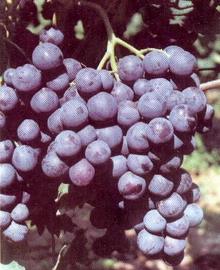
MISKET RUSENSKI
It ripens at the end of July, the beginning of August, 15 days before Kardinal. The cluster is large, 300 g, loose. The berry is large, 4,8 g, ovate, black. The consistence is crisp, the taste – musket. The yield (t/da) is 1,3. The grapes are rot resistant and transportable. It contains 16% sugars and 4,3 g/l acids.
The cultivar is appropriate to be grown at all vine-growing regions and hilly areas up to 700-800 m above sea level.
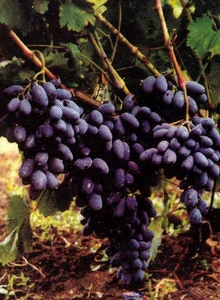
SIYANA
It ripens at the middle of October. The cluster is large, 530 g, loose. The berry is very coarse, 10 g, long, black, with 2 seeds mid-size. The consistence is crisp and the taste – neutral. The yield of grapes is about 2 t/da. The grapes contains 17% sugars and 5,4 g/l acids. It preserves fresh on the root for a long time after the ripening and is highly transportable.
The cultivar is recommended for production of late table grapes intended for realization on the market also in winter. It is recommended to be cultivated at the warmest regions of the country.
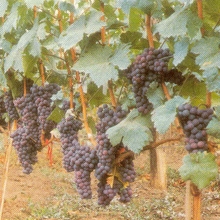
PAMID RUSE 1
It ripens at 12-15 of September, 10 days earlier than Pamid cher. The cluster is mid-large, 260 g. The berry is 3,2 g, 30% larger in weight and size than Pamid cher. The grapes contains more sugars (19,2%) and acids (3,92 g/l), compared to the control form 18,5% and 3,25 g/l, respectively. The yield of grapes is 1,9 t/da. Pamid Ruse 1 does not put forth aments and abscission of the berries is not observed. It manifests a strong recruiting ability in frost bite and with lower susceptibility to powdery mildew and rot.
It is appropriate for consummation in fresh condition and for making of qualitative wine.
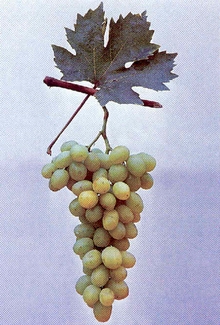
RYAHOVO
It ripens towards 25 of August. The cluster is semi-large, 450 g, semi-compact. The berry is very coarse, 7,0 g, ovate, green-yellow. The consistence is crisp, the taste – delicate musket. The yield of grapes is 2,0 t/da. The grapes contains 16% sugars and 5,0 g/l acids. It is transportable. The thinning out of berries 10-15 days before ripening sharply increases their sizes and betters the appearance of the cluster.
The cultivar can be cultivated at the typical viticultural regions in the country and at foothill places under lee and in the sun.
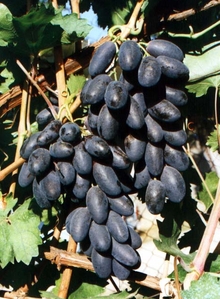
VELIKA
It ripens towards 20 of August, at one and the same time with Kardinal. The cluster is large, 500 g, loose. The berry is very coarse, long, black, with 1-2 small often soft seeds. The consistence is crisp and the taste – neutral, harmonious. The yield of grapes is over 2 t/da. The grapes contains 16% sugars and 6,0 g/l acids, which determines its high gustatory qualities. It has a good transportability.
The cultivar can be cultivated also at foothill places, facing south and 400-500 m above sea.
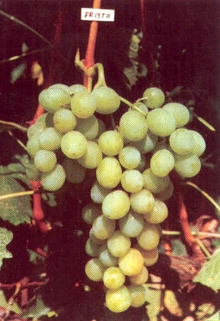
PRISTA
It ripens towards 15 of August, before Kardinal. The cluster is large, 380 g, semi-compact. The berry is coarse, 5,3 g, ovate, green-yellow. The consistence is crisp, the taste – musket. The yield of grapes is 1,5 t/da. The grapes contains 16% sugars and 4,0 g/l acids. It is transportable and rot resistant.
The cultivar is appropriate for production of early grapes in the open and in glass houses. The cultivar can be cultivated also at foothill places up to 600-700 m above sea.
WINE VINE VARIETIES
Misket Viking
Misket Viking was created in 1996 in IASS “Obraztsov chiflik” – Rousse, via hybridization of Naslada and Chardonnay cultivars.

It is comparatively early ripening, with strong growth and good productivity. The length of the vegetation period from budding to the physiological maturity of grapes is about 155 days. The consumptive ripeness of grapes in the region of Rousse occurs around September 15.
Misket Viking is a typical wine variety. The cluster is medium-sized (16-17 cm), conical, sometimes winged, medium compact, with short to medium long fruit stalk (4-7 cm). The berry is medium-coarse (13,71/13,14 mm), oval, yellow-green colored, with musket flavour.
The average weight of cluster is about 120 g, and berry – 1.92 g. The consistency of berry is fleshy and juicy, and the taste is harmonious with a musket flavour. In technological maturity grapes contain 22.55% sugars and 9.01 g/l titratable acids. Characteristic of the hybrid is the good ratio of glucose and fructose with a predominance of fructose, which indicates good ripeness of grapes. The titratable acidity is well preserved for a white wine. Malic acid predominates, which gives a slightly green acidity. Grapes do not crumble and have a very good transportability, suitable for the production of white high quality wines.
Musket Viking grows well and bears fruit well, grafted on SO4 and Chasselas X Berlandieri 41B rootstocks. In half-standard Guyot formation and density of plantation 2,50/1,20 m the yield of grapes per hectare is about 12 t. The vines have potential abilities for higher yield in Moser and Ombrella formations and drip irrigation.
The variety has increased winter resistance, and medium resistance to diseases within the limits of Euro-Asian vine Vitis vinifera L., and requires limited treatment against mildew and powdery mildew, only in the presence of very high humidity (soil and air) under conditions of natural infectious background. In case of severe damage from extreme cold below minus 18-20oС, it shows good regenerative ability.
Misket Viking is suitable for growing in all types of formations, in the regions of the country with favorable conditions for development and fruiting of early and medium ripening wine white grape varieties.
Kristalen variety
Kristalen variety is created in 1996 in IASS “Obraztsov chiflik” – Rousse, via hybridization of Pamid Ruse1 and Kaylushki misket.
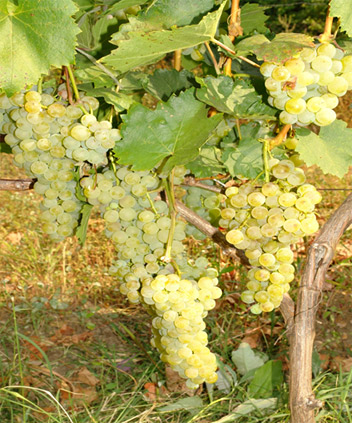
It is early ripening with strong growth and good productivity.
The length of the vegetation period from budding to the physiological maturity of grapes is about 150 days. The consumptive ripeness of grapes in the region of Rousse occurs around September 5.
Kristalen is a typical wine variety. The cluster is medium-sized (16 cm), conical, sometimes winged, medium-compact, with a short to medium-long stalk (4-7 cm). The berry is medium (14.53/13.51 mm), oval, yellow-green colored, with musket flavour. The average weight of cluster is about 196.5 g, and berry – 2.73 g. The consistency of berry is fleshy and juicy, and the taste is harmonious with a musket flavour. At consumptive maturity, the grapes contain 19.26% sugars and 7.42 g/l titratable acids, do not crumble and have a very good transportability.
The grapes have pronounced fruity and musket flavour, pleasant freshness and are suitable for the production of white high quality wines, dense and with good harmony between alcohol, sugars and titratable acids and for the production of high alcoholic beverages.
Kristalen variety grows well and bears fruit well, grafted onto SO4 and Chasselas X Berlandieri 41B rootstocks. In half-standard Guyot formation and density of plantation 2,50/1,20 m the yield of grapes per hectare is over 12 t. The vines have potential abilities for higher yield in Moser and Ombrella formations and drip irrigation.
The variety has increased winter resistance, and is resistant to diseases within the limits of Euro-Asian vine Vitis vinifera L., and requires limited treatment against mildew and powdery mildew, only in the presence of a very high humidity (soil and air) under conditions of natural infectious background.
In case of severe damage from extreme cold below minus 18-20oС, it shows good regenerative ability. Kristalen variety is suitable for growing in all types of formations, in the regions of the country with favorable conditions for growth and fruiting of early and medium ripening wine white grape varieties.


